
The Fabaceae or Leguminosae, commonly known as the legume, pea, or bean family, are a large and agriculturally important family of flowering plants. It includes trees, shrubs, and perennial or annual herbaceous plants, which are easily recognized by their fruit (legume) and their compound, stipulate leaves. The family is widely distributed, and is the third-largest land plant family in number of species, behind only the Orchidaceae and Asteraceae, with about 765 genera and nearly 20,000 known species.

The Faboideae are a subfamily of the flowering plant family Fabaceae or Leguminosae. An acceptable alternative name for the subfamily is Papilionoideae, or Papilionaceae when this group of plants is treated as a family.

Glycine is a genus in the bean family Fabaceae. The best known species is the cultivated soybean. While the majority of the species are found only in Australia, the soybean's native range is in East Asia. A few species extend from Australia to East Asia.
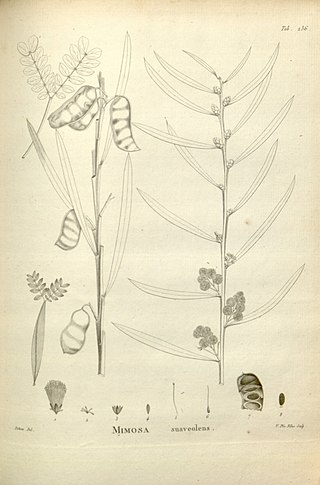
Phyllodes are modified petioles or leaf stems, which are leaf-like in appearance and function. In some plants, these become flattened and widened, while the leaf itself becomes reduced or vanishes altogether. Thus the phyllode comes to serve the purpose of the leaf. Some important examples are Euphorbia royleana which are cylindrical and Opuntia which are flattened.
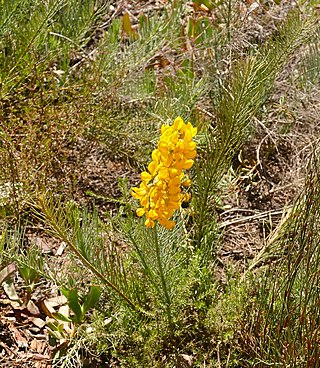
Lebeckia is a genus of plants in the family Fabaceae native to the fynbos of South Africa. Several members of Lebeckia were recently transferred to other genera. Members of Lebeckia are known to produce pyrrolizidine alkaloids, including ammodendrine, lebeckianine, and lupanine. The genus was named by Carl Thunberg for his student Heinrich Julius Lebeck.
Leobordea adpressa is a species of flowering plant in the family Fabaceae. It is found in Lesotho and South Africa. Its natural habitat is temperate grassland.

Lotononis is a genus of flowering plants in the family Fabaceae and the tribe Crotalarieae. Almost all of the species in the genus occur in southern Africa.
Leobordea mirabilis is a known species of legume in the family Fabaceae. It is endemic to Namibia. Its natural habitat is rocky areas.

Crotalarieae is a tribe of flowering plants belonging to the family Fabaceae. It includes rooibos (Aspalathus linearis), harvested for sale as a tisane.
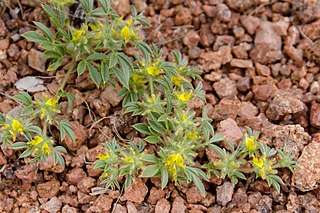
Leobordea platycarpa is a common annual plant in the drier parts of the African continent found in open ground, roadsides, cultivated ground and other disturbed places or in short grassland on sand.

Podalyria is a genus of flowering plants in the family Fabaceae. It belongs to the subfamily Faboideae. The genus is endemic to South Africa.
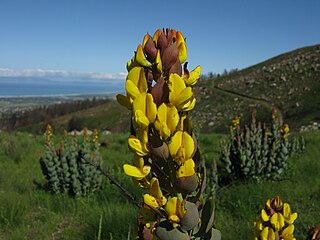
Rafnia is a genus of flowering plants in the family Fabaceae. It belongs to the subfamily Faboideae.
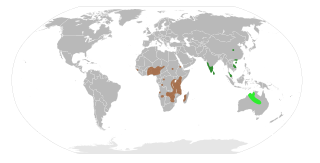
Rothia is a genus of flowering plants in the family Fabaceae. It belongs to the tribe Crotalarieae of subfamily Faboideae, and comprises two species:
Ezoloba macrocarpa is a species of flowering plant in the family Fabaceae and the tribe Crotalarieae found in South Africa. It is the only species included in the genus Ezoloba.
Listia is a genus of flowering plants in the family Fabaceae and the tribe Crotalarieae. Members of this genus are mainly found in southern Africa but some species can be found in central Africa. It was recently segregated from the genus Lotononis. Unlike other members of the Crotalarieae, members of the genus Listia have lupinoid root nodules.

Leobordea is a genus of legumes in the family Fabaceae and the tribe Crotalarieae. Members of this genus are found in the eastern parts of South Africa as well as tropical Africa and the Mediterranean countries. It was recently segregated from the genus Lotononis.
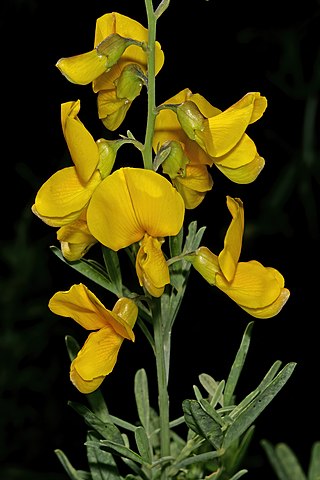
Calobota is a genus of flowering plants in the legume family, Fabaceae. It includes 16 species native to North Africa and southern Africa. It belongs to the subfamily Faboideae.

Genisteae is a tribe of trees, shrubs and herbaceous plants in the subfamily Faboideae of the family Fabaceae. It includes a number of well-known plants including broom, lupine (lupin), gorse and laburnum.
Parasa euchlora is a species of moth in the genus Parasa. It is in the family Limacodidae and the subfamily Limacodinae.













